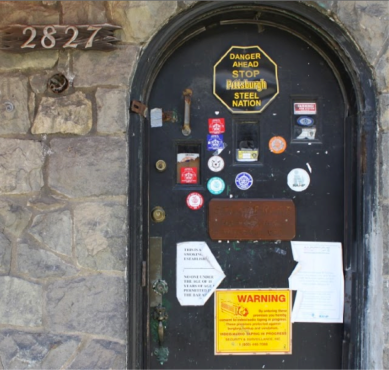Blog Archives
Stonefront Witch Way Inn Files for Chapter 11
Posted by Salene Mazur Kraemer
BY: Katie Imler, Law Clerk
On July 26, 2013 , TAM of Allegheny LLC d/b/a Stonefront Witch Way Inn filed a voluntary petition for relief under Chapter 11 of the Bankruptcy Code in the Western District of Pennsylvania (assigned No. 13-23143-GLT). The Stone Front Witch Way Inn, located at 2827 California Avenue, Pittsburgh, PA 15212, was a local café and bar that was padlocked by police on June 28, 2013 for not paying the Allegheny County drink taxes totaling more than $22,390. The Allegheny County Treasurer, John Weinstein, has been cracking down on businesses that are not paying the alcoholic beverage tax.
The case has been assigned to the Honorable Judge Gregory L. Taddonio. Norma Hildenbrand has filed an Notice of Appearance and Request for Notice on behalf of the United States Trustee. A summary of the docket can be found here.
The Debtor listed $50,000-$100,000 in Assets and $0-$50,000 in Liabilities, which are primarily business debts. Although there are less than 50 creditors, the top creditors holding unsecured claims include: Allegheny County ($21,864), BMI ($658.07), Chase Bank ($2,723.39), Dietz Electronics, Inc. ($438.98), IRS ($8,058.44), Joseph J. Brunner, Inc. ($407.80), and Trudy L. Schmitt, President of TAM of Allegheny LLC. All Schedules and Attorney Disclosures are due on August 9, 2013. The Chapter 11 Plan and Disclosure Statements are due November 25, 2013. However, the Government Proof of Claims Bar Date is set for January 22, 2014.
The Debtor is represented by J. Michael Baggett of McCann Garland Ridall & Burke, 11 Stanwix Street, Suite 1030, Pittsburgh PA, 15222. Jodi L. Hause filed a Notice of Appearance on July 29, 2013 to represent Creditor Duquesne Light Company. A Status Conference will be held on October 20, 2013 at 10:00am.
Posted in Chapter 11 Debtors, Creditor Issues, New Chapter 11 Filings, PA Chapter 11 Debtors, Pittsburgh, small business debtor cases, tax issues, Uncategorized
Tags: alcohol tax, Allegheny county, attorney, bankruptcy, bar, Bellevue, beverage tax, business law, chapter 11, Chase Bank, commercial bankruptcy, creditor, debtor weirton, Dietz Electronics, drink tax, firm, hire, john weinstein, Katie Imler, law, lawyers, Mazur Kraemer, mazurkraemer, pittsburgh, recruit, salene, stonefront, tax, witch way, WV
Inside the Trenches of a Chapter 11 Bankruptcy Case-Preparing the Initial Filing
Posted by Salene Mazur Kraemer
In the world of business law, many seem to be mystified by the chapter 11 bankruptcy process. When I tell my friends and colleagues what I do, they still don’t seem to understand me. I get that glazed, deer-in-headlights look. I just recently filed a Chapter 11 case and I decided to write a series of blog posts as we are going through the process.
The chapter 11 process is expensive but can be a worthwhile option and a financially prudent decision for certain businesses wishing to reorganize, restructure their debts, reject undesirable contracts, and/or orderly liquidate certain assets under the jurisdiction and protection of the bankruptcy court.
Triggering Event. Usually an event triggers the filing (a pending auction of assets, an inability to payroll, the threat of a shut-off notice for utilities, a impending freezing of bank accounts, a filed lawsuit, etc.). A debtor can file an emergency petition in such an instance.
 Emergency Petition. To file an emergency petition, at the very minimum a debtor needs to submit the 2-page petition, its list of 20 largest unsecured creditors, and a creditor matrix (listing all of the creditors the debtor believes it currently has). This sounds like a simple initial filing; but, it might not be. The preparation of the debtor’s bankruptcy petition and related schedules can be very time-consuming depending upon the nature of the debtor’s business, how orderly its books and records are, and how many divisions or locations, it has etc.
Emergency Petition. To file an emergency petition, at the very minimum a debtor needs to submit the 2-page petition, its list of 20 largest unsecured creditors, and a creditor matrix (listing all of the creditors the debtor believes it currently has). This sounds like a simple initial filing; but, it might not be. The preparation of the debtor’s bankruptcy petition and related schedules can be very time-consuming depending upon the nature of the debtor’s business, how orderly its books and records are, and how many divisions or locations, it has etc.
Automatic Stay. Once the minimal skeletal documents are filed, an “automatic stay” goes into immediate effect; the automatic stay is basically an injunction against any and all actions against the debtor and is property. If a creditor violates the stay, it is a serious infringement and the bankruptcy court can award sanctions against the creditor.
After the initial bankruptcy petition is filed, a Ch. 11 debtor has another 14 days within which to file its complete schedules and statement of financial affairs. This timeframe can be extended for cause.
“Debtor In Possession” Bank and Insurance Information. Also once the petition is filed, generally within 10 days, the debtor and its counsel have to submit certain bank account and insurance information to the United States Trustee (part of the Department of Justice). Importantly, a business must close its books as of its bankruptcy “Petition Date” and open up a new set of financial books and records. New “Debtor-in-Possession” (“DIP”) Bank accounts must be opened at certain approved banks; the United States Trustee’s Office has the “approved” list of banks. The debtor and its counsel also may have an initial debtor interview with the agent for the United States Trustee (depending upon the district in which you file), at which the debtor discusses its business operations and assets and liabilities.
The Bankruptcy Court Is Watching. Once a bankruptcy petition is filed, a business will then have to seek bankruptcy court approval prior to taking many actions (paying its lawyers and accountants, paying pre-petition wages, utilizing cash (“cash collateral”) to pay expenses, selling anything outside the ordinary course). A business debtor post-petition generally CANNOT pay any pre-petition obligations, otherwise serious consequences may ensure, including “avoidance” lawsuits.
 Drama. The initial filing process can be intense for everyone involved. Lots of information gathering, document review, fact checking. Many phone calls may be made to and from creditors about the impact of the filing of the case.
Drama. The initial filing process can be intense for everyone involved. Lots of information gathering, document review, fact checking. Many phone calls may be made to and from creditors about the impact of the filing of the case.
Often, a distressed situation, not surprisingly, involves drama. In some instances I have had to file the case right before the auction on the courthouse steps, right before the repossession crew found the vehicle, or right after the doors to a business were locked and the business suddenly went dark. After the petition is filed and is made known to the public, media outlets may starting calling to find out more about the future of the business.
STAY TUNED FOR MORE DETAILS REGARDING INSIDE THE TRENCHES OF A CHAPTER 11 BANKRUPTCY CASE
MAZURKRAEMER represents debtors and creditors in bankruptcy courts all over the country. The information, comments and links posted on this blog do not constitute legal advice. No attorney-client relationship has been or will be formed by any communication(s) to, from or with the blog and/or the blogger. For legal advice, contact an attorney at MAZURKRAEMER or an attorney actively practicing in your jurisdiction.
Posted in Chapter 11 Debtors, Gettting Schedules Filed, Uncategorized
Tags: 11, 547, 548, 550, 7, accounts, action, attorney, auction, avoidance, bank, bankruptcy, business, chapter, commercial, creditor, default, emergency, filing, firm, foreclosure, fraudulent, freeze, going, guaranty, judgment, kraemer, law, lawyer, Lender, liens, liquidation, mazur, mazurkraemer, new jersey, options, pittsburgh, post-petition, preference, process, reorganization, restructure, salene, seize, tax, transfers, trenches, weirton, West Virgini


